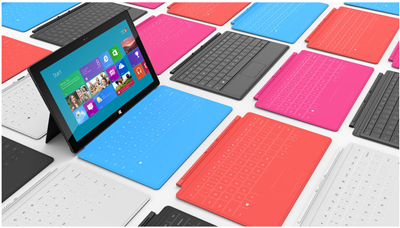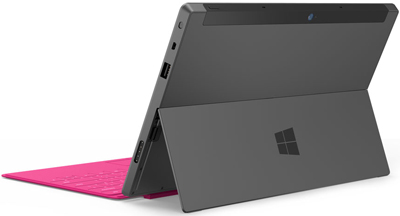In-Depth
'Surface' Observations About Microsoft's New Tablets
Microsoft finally took the wraps off its "Surface" tablet, and it's pretty striking. While it's too early to tell whether Surface will be a coup or a flop, Monday's launch event gave us plenty to think about. Here are our first impressions.
- By Scott Bekker
- June 19, 2012
Microsoft launched its own line of tablets, called Surface, on Monday evening. In a project so secretive that speculation prior to the surprise event in Los Angeles ran the gamut from a Nook-related device from the Barnes & Noble collaboration to some sort of Xbox announcement, it seems that no one knew Microsoft was bringing its own weapons to the tablet wars. At a high level, Microsoft will have a consumer device running Windows RT available for the Windows 8 launch and a Windows 8 Pro device 90 days later. We haven't gotten our hands on a Surface yet, but here are some observations about the devices based on the announcement and the promotional materials.
Microsoft Is in the PC Hardware Business
Microsoft has offered Zunes, Xboxes, mice and keyboards, but never a full-blown PC. Now Microsoft is offering tablets just as it's trying to get OEMs to embrace that form factor. Perhaps limiting sales to Microsoft Stores and online is an attempt to soften the blow to partners like Asus, Acer, Dell, Hewlett-Packard, Lenovo and Toshiba who have already announced Windows RT and Windows 8 tablets of their own. At least for now, Microsoft is also sort of promising not to undercut other Windows tablet makers on price (read on for Microsoft's specific wording about OEMs and prices).
You can see where Microsoft is coming from on releasing its own tablet. Bill Gates had been talking about tablets for more than a decade, and hardware partners have been making tablets for years, but they've remained niche devices. Apple came out with its integrated hardware/software iPad and made the tablet mainstream while Microsoft watched from the sidelines.
On the other hand, Windows 8 represents the first time that the UI is really about tablets and not an effort to shoehorn the traditional Windows OS into another form factor. This may be the first OS from Microsoft that really has a chance to go mainstream on tablets. After extending that rug to OEMs, Microsoft is now pulling it halfway back. Microsoft doesn't show any indication of getting into laptops and desktops, but the tablet is where the market opportunity seems to be right now. Microsoft has just made its ecosystem relationships a lot more complicated.
Microsoft acknowledged the difficult box in which it's putting its partners with this statement in the news release:
"One of the strengths of Windows is its extensive ecosystem of software and hardware partners, delivering selection and choice that makes a customer's Windows experience uniquely their own. This continues with Surface. Microsoft is delivering a unique contribution to an already strong and growing ecosystem of functional and stylish devices delivered by original equipment manufacturers (OEMs) to bring the experience of Windows to consumers and businesses around the globe."
Touch Cover
Moving on to the specifics of the device, the most striking innovation in Microsoft's Surface is the Touch Cover. It riffs on Apple's iPad Smart Cover, the brightly colored accessory that connects to the iPad magnetically on one edge, protects the screen when it's not in use and folds into a kickstand that can prop up the iPad. Microsoft's innovation is to lay out the removable cover when it's not protecting the Surface screen and turn it into a keyboard. For a company that wants to position its tablets as grown-up, business-capable alternatives to the toys on the market, the Touch Cover is brilliant.
 |
The Touch Cover comes in two types. A 3-mm-thick version uses pressure-sensitive technology to sense keystrokes as gestures and comes in bright colors. From a promotional shot, it looks like the options will be grey/white, pink, turquoise and orange. A 5-mm version in black offers moving keys for a more traditional typing experience. It will all come down to implementation. Looks great on a promotional shot; we'll have to experience the two Touch Covers to see how actual typing goes.
Kickstand
Because Microsoft's Touch Cover won't fold into a kickstand, Microsoft needed another way to prop up the device. The solution is a Kickstand that pops out of the back of the device to allow it to be propped up while typing or watching movies. Microsoft bills the 22-degree angle that the Kickstand and Surface's edges allow as a natural position for the screen. A camera on the back of the device is also angled at 22 degrees for recording meetings and events hands-free. The angled camera seems like a design decision that will be loved by some and hated by others. (There's a front-facing camera too.)
 |
Skype Integration Starts Here
The big question since Microsoft acquired Skype has been, "What is Microsoft doing with that $8.5 billion investment?" One answer is in the Surface. Stereo speakers and dual microphones are tuned for Skype. While the natural position for Skype would be to use the front-facing camera to see and talk to someone, a promotional shot shows a family sitting in their kitchen facing what looks like the angled rear-facing camera.
Price Is a Mystery
An extremely important detail about the Surface is missing. That is how much it will cost. As we've noted before, the emerging opinion in tech business circles is that Microsoft and its OEM tech partners must deliver their ARM and x86 tablets for less than the cost of comparable iPads or the products will be in trouble. A recent flap at Computex involving OEMs unhappily telling a reporter that they'll be paying around $85 per copy of Windows RT provided a possible signal that Microsoft may not believe this lesson. Microsoft may think the consumer-plus-business package gives them some leeway.
We don't know what Microsoft is planning at this point, other than a promise not to undercut OEMs. Per Microsoft's news release:
"Suggested retail pricing will be announced closer to availability and is expected to be competitive with a comparable ARM tablet or Intel Ultrabook-class PC. OEMs will have cost and feature parity on Windows 8 and Windows RT."
That doesn't sound like cost parity with the iPad, let alone beating the iPad on price, but we'll see.
Conclusion
In all, the radically different Windows 8/RT operating system now has exciting hardware with some strong differentiating features that allow Microsoft to mount a unified challenge to the Apple iPad. How much the Surface will cost, and how much damage Surface's existence does to Microsoft's relationships with hardware partners, are the big question marks.
More Surface Coverage on RCPmag.com:
About the Author
Scott Bekker is editor in chief of Redmond Channel Partner magazine.